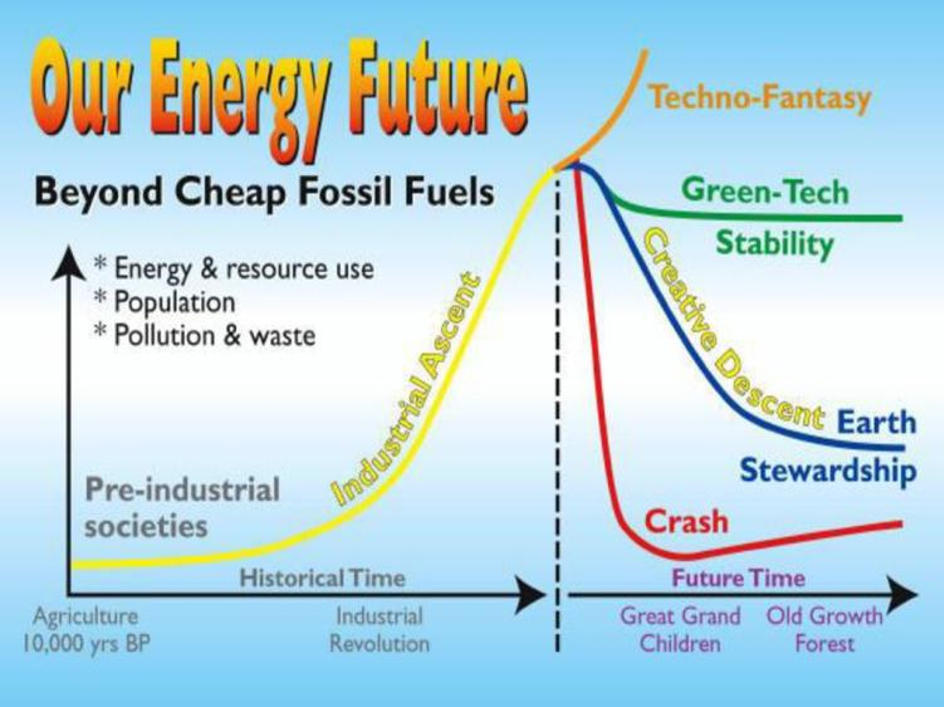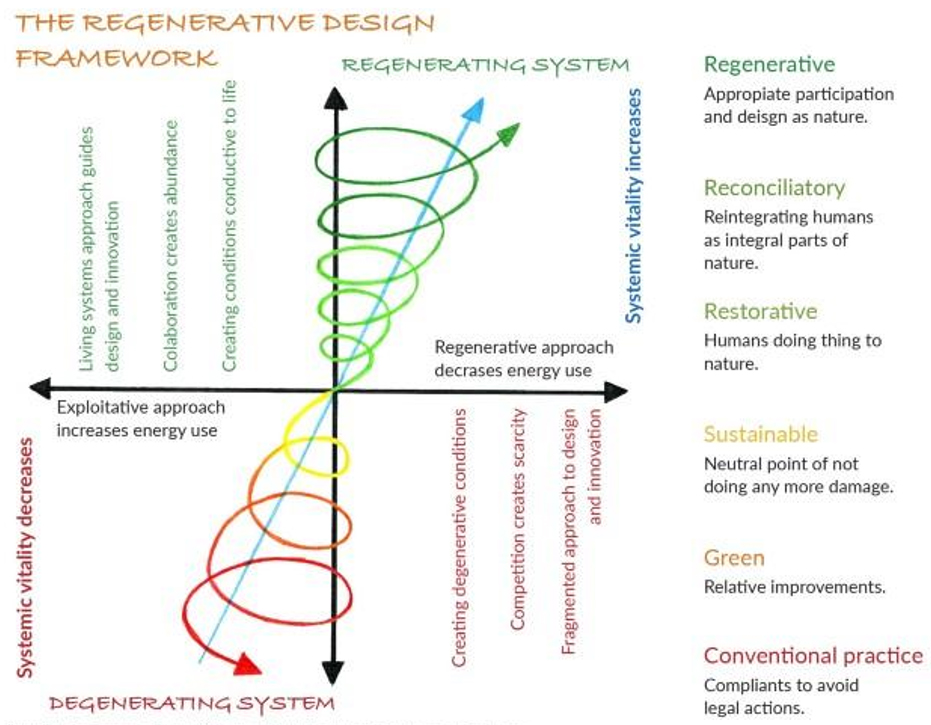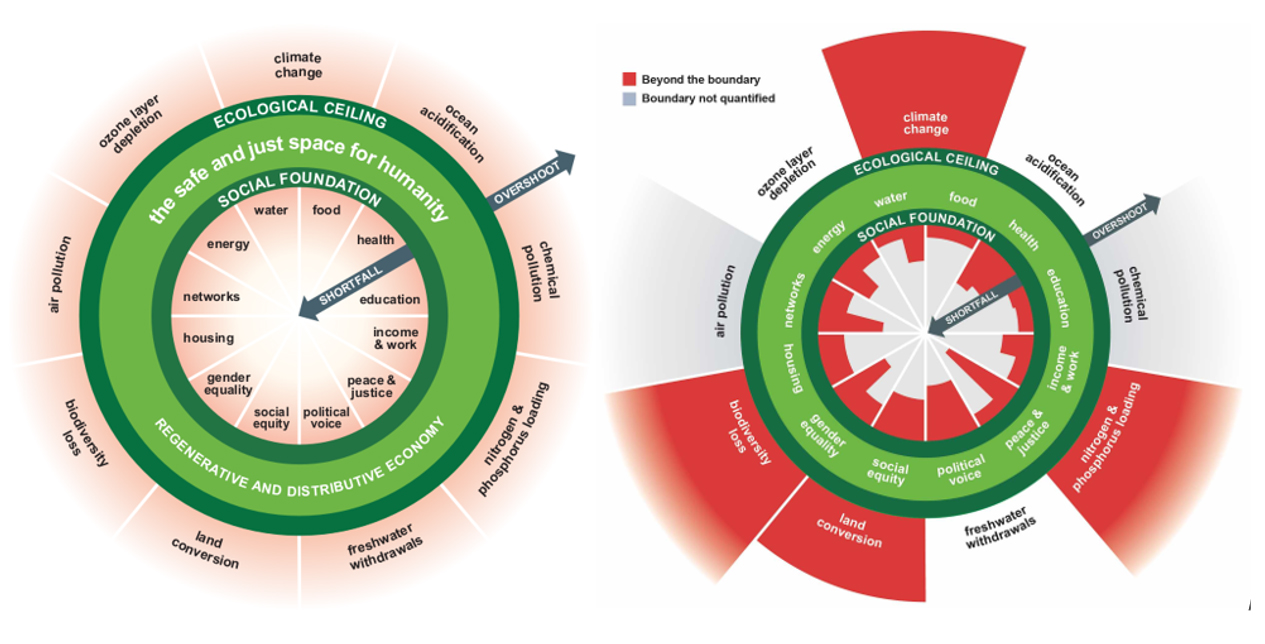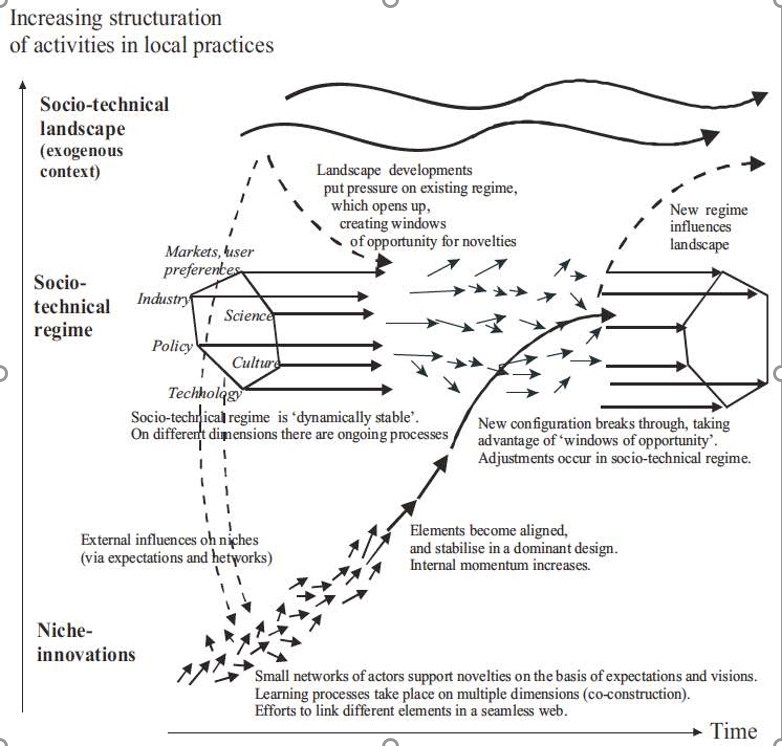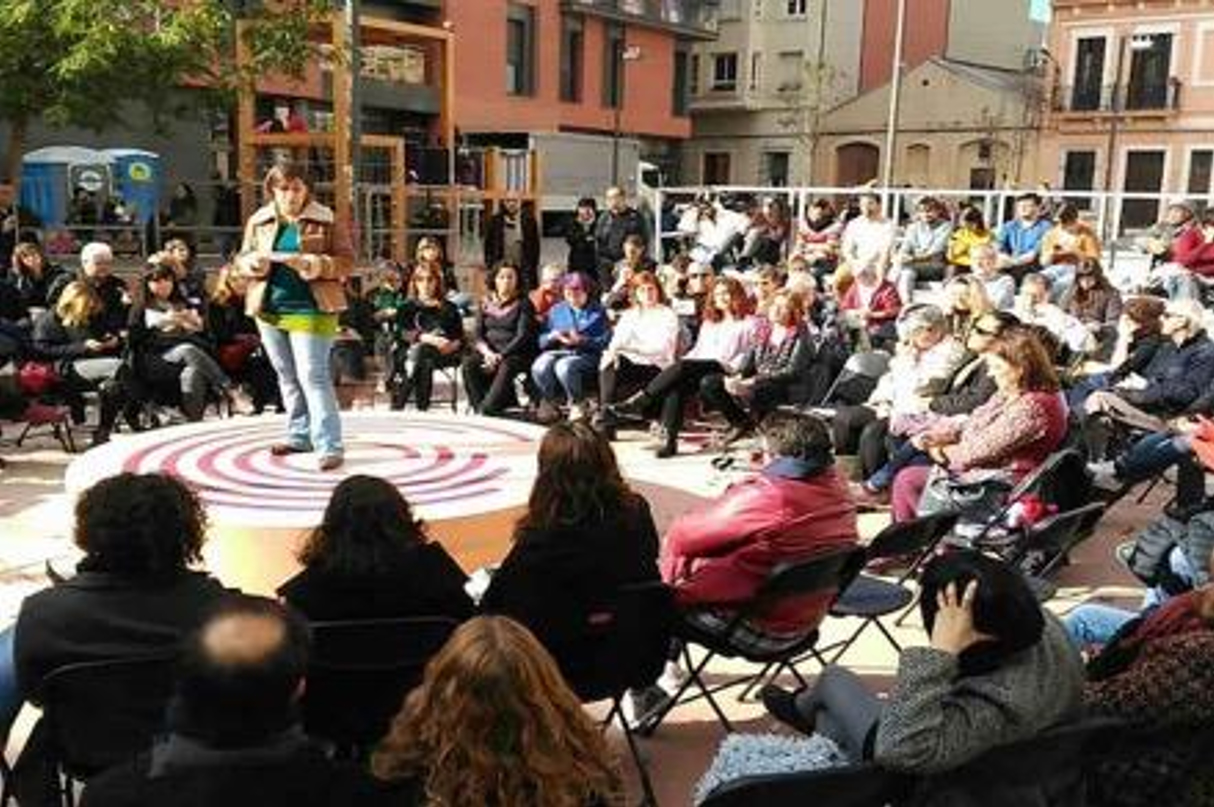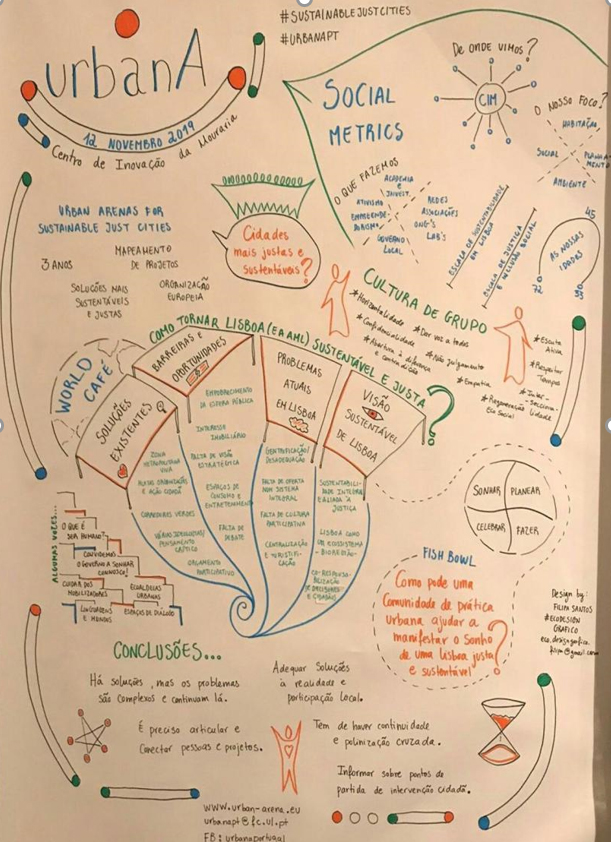Introduction
Global climate emergency declarations in 2019 (1,400 local governments, 28 countries) have highlighted the fact that decades of sustainable development have not adequately tackled what Monbiot (2013) suggest we call climate breakdown (CB). What is finally accepted, despite warnings for over half a century (Bookchin, 1964), is that failure to understand the full severity of the threat from today’s global crises, followed by appropriate action, threatens humanity’s survival (Capra, 1996; Klein, 2014). Agreeing that urban transitions (Frantzeskaki et al, 2018) are the frontline of the necessary response to the crises, the paper advocates moving beyond sustainable urban planning to regenerative urban planning, based upon the ideas of regenerative design and development to create regenerative communities (Reed, 2007), cities (Girardet, 2010, 2014), economy (Raworth, 2017), cultures (Wahl, 2016) and planet. In short, moving from “doing less damage to the environment” (Reed, 2007) to a holistic systems approach that seeks to “reverse the degeneration of the earth's natural systems, but also to design human systems that can coevolve with natural systems” (Mang & Reed, 2013). With governments so far being unable to enact necessary changes, or without clear policy guidance, the paper proposes active organised urban communities of scale are the key to responding to the combined challenges of planetary urbanization (Lefebvre, 1970; Merrifield, 2013) and the hydrocarbon twins (Hopkins, 2008) of climate change and peak oil. These components of urban regeneration, coupled with equality and social justice, form the base of what is presented as ecocity transformation, which the paper proposes as the normative goal of contemporary cities.
Responding to CB for many decades, a diverse range of community-led initiatives (CLIs) have been “actively envisioning, creating and living within alternatives that are rooted in sustainability, equality and social justice” (Penha-Lopes, Henfrey, et al, 2019). These CLIs are both urban and rural, and focus on a diverse range of solutions. Wide variety in analysis of actual problems exist, with each community focusing on what matters for them. Penha-Lopes and Henfrey note that CLIs are “far from realising their potential as catalysts for society-wide transformation”. This paper stems from ongoing work using a transdisciplinary, participative action research method to help develop an urban systems Community of Practice (CoP), which is part of the “Communities for Future” ecosystem, working toward the eco-social just transition needed to respond to CB. This community-led ecocity transformation is based around urban communities that are active in nested structures of scale, from the bottom to the top, from the street, to the neighbourhood, the municipality, wider city, bioregion and planet.
Global Ecovillage Network (GEN), “envisions a world of empowered citizens and communities, designing and implementing pathways to a regenerative future, while building bridges of hope and international solidarity” (GEN, 2020). GEN has over 15,000 ecovillages in their network, but very few are urban. The paper explores how GEN can scale to where “every city (is) a green city” (Joubert, 2017) for large contemporary cities. It examines urban transition examples already transforming territories at different scales and mechanisms enabling translocal CoPs (Wheatley & Frieze, 2006) communicate, govern and implement regenerative visions. It develops an ecocity transformation process that is a fractal-like, multi scaled, community-led, bottom up planning process to enable citizens design the futures they desire for their territories, incorporating greater equity, energy descent and climate adaptation.
The paper seeks to contribute to planning theory and practice by showing how regenerative development frameworks adequately tackle CB. Attempting to bridge activism and academia, this work uses a transdisciplinary participative action research method, developing an Urban Systems CoP with: 1) The European Network for Community-Led Initiatives on Climate Change and Sustainability (ECOLISE); 2) UrbanA, a 3-year Horizon 2020 project based around Urban Arenas for Sustainable and Just Cities, which ECOLISE is a partner of; 3) Communities for Future (CfF), ECOLISE’s action platform that is mainstreaming regenerative and transformative community-led action on climate change and sustainability. Case studies from Rojava, São Paulo and Barcelona demonstrate governance structures working in a nested, scaled, citizen-led way. Regenerative opportunities are explored with three Lisbon based CLIs working in marginalised territories.
The paper comprises four sections: The first section outlines the need to move from sustainability to regenerative design. It explores what regenerative frameworks (Du Plessis, 2012; Raworth, 2017) mean for urban planning, cities and citizens. It builds on degrowth critiques of green growth logic (Hickel & Kallis, 2020) to position regenerative planning frameworks within Holmgren’s permaculture creative descent strategies. The second section examines how a CoP ecosystem can enable eco-social just transition. It introduces the various, and at times contradictory, stages of the ecocity concept and offers a regenerative development proposal based upon scaling GENs methodology, so that “every city is an ecocity”. The third section turns to Europe’s 2020 “Green Capital” Lisbon and three CLIs, exploring how to create more sustainable and equitable cities. The article finishes with discussion and conclusions, including how future research and action can enable wider regenerative, urban change.
1. Beyond Sustainability to Regenerative Development
Climate and biodiversity emergency declarations made by various governments in 2019 are to be welcomed, but pathways for urban transitions to resolve the crises need better articulation. Recognizing that “modern cities are a product of the oil age” (Brown, 2006, p.36), permaculture practitioners recommend creative descent responses where factors accelerating CB are lowered intentionally by human design, back to within planetary limits. Permaculture co-founder David Holmgren offers (Image 1) four distinct near future scenarios (2009). At the extremes are: 1) Techno-Fantasy, the delusion that infinite growth can occur on a finite planet; 2) Crash, also called Mad Max Collapse, similar to the film’s nightmare situation; 3) Green-Tech Stability, where todays non-sustainable levels of 1.6 Earths are somehow maintained; 4) Creative Descent, or Earth Stewardship, whereby humankind responds to the Hydrocarbon Twins (Hopkins, 2008) of climate change and peak oil, to create Post Carbon futures (Heinberg, 2003) that function within the earth’s limits.
The Brundtland Report (1987) popularized sustainability, but decades of Sustainable Development have failed to adequately tackle CB. Since the 1970s, humanity has been in ecological overshoot using resources faster than can be replenished. Today humanity uses the equivalent of 1.6 Earths to provide the resources we use and to absorb our waste. Even though todays cities occupy just 2% of the Earth’s land, they account for 60% of energy consumption, 70% carbon emissions and 70% Global Waste (UN, 2015). These percentages continue to rise with what Lefebvre called the “complete urbanization of society” (1970) and Merrifield later neatly labelled Planetary Urbanization (2013). Indian environmentalist Vandana Shiva summarised: “The earth is rapidly dying: her forests are dying, her soils are dying, her waters are dying, her air is dying” (1988, p. xii). Failure to respond appropriately to the crises could lead to the delicate system that sustains human life crossing a series of climate tipping points which poses an existential threat to civilisation (Lenton, T. et al, 2020). The complexity of the problem requires a holistic whole systems approach (Capra, 1996), knowing how to identify leverage points, the best moments or places to intervene in the system (Meadows, 1999).
Wahl claims boldly: “Sustainability is not Enough: We Need Regenerative Cultures” (2016). Although positive, the growing viewpoint sees sustainability as “doing less damage to the environment” (Reed, 2007), whereas regenerative development transcends and includes sustainability, in a holistic systems approach to “reverse the degeneration of the earth's natural systems, but also to design human systems that can coevolve with natural systems” (Mang & Reed, 2013). Wahl (Image 2) adapts Reeds Regenerative Design Framework (2007) to identify six incremental stages between degenerative and regenerative systems; from ‘business as usual’ (conventional practice) to full regeneration (appropriate participation and design as nature), that is positioned beyond and transcends sustainability (not doing any more damage):
The aim of creating regenerative cultures transcends and includes sustainability. Restorative design aims to restore healthy self-regulation to local ecosystems, and reconciliatory design takes the additional step of making explicit humanity’s participatory involvement in life’s processes and the unity of nature and culture. Regenerative design creates regenerative cultures capable of continuous learning and transformation in response to, and anticipation of, inevitable change. Regenerative cultures safeguard and grow biocultural abundance for future generations of humanity and for life as a whole. (Wahl, 2016)
Having established regenerative solutions best respond to CB, we explore regenerative design frameworks that are enabling a systems approach to urban planning. Before that, an important problem with the sustainability model must be addressed.
1.1. Degrowth, doughnuts and regenerative development
Acknowledging important steps happened recently to focus thinking and action on ecological and social crises: Paris Agreement, 2015; Sustainability Development Goals (SDGs), 2015; New Urban Agenda, 2016, a fundamental problem needs addressing: Economic growth. The Limits to Growth (Meadows et al, 1972) identified perpetual quantitative growth on a finite planet as impossible, yet SDG8 is positioned; “Decent work and economic growth”. In conversation with Capra, Wahl (2019), calls for a systems approach to the SDGs, identifies SDG8 as the spanner that “sabotages the implementation of all the other goals” and suggests it be reframed as ‘Good Work and Qualitative Growth”, adding “that alone would start a conversation about what kind of growth we want”. Speaking about an often-misunderstood word, academic theory and social movement, Capra responds that the Degrowth movement is all about qualitative growth and need to be worked with. But, because semantics matter, he adds: “degrowth, it doesn’t sound right to me”.
Degrowth is an academic theory and quickly growing social movement. It is noted that “English speakers sometimes find the word ‘degrowth’ problematic” (degrowth.info, 2021) because it has negative connotations. The terms origins come from Latin languages, in Italian “la decrescita” refers to a river going back to its normal flow after a disastrous flood, a fitting metaphor for creative descent strategies. The English word “degrowth” became prominent after the first international degrowth conference in Paris in 2008, Hickel (2020) describes it as “a planned reduction of excess energy and resource use in rich nations to bring the economy back into balance with the living world, while reducing inequality and improving people’s access to the resources they need to live long, healthy, flourishing lives”. Hickel & Kallis (2020) doubt the World Bank and OECD’s promotion of green growth can act as a route out of ecological emergency, urging that “policy programmes that rely on green growth assumptions - such as the SDGs - need urgently to be revisited”. They advocate post growth, post capitalist alternatives to decouple prosperity and development from growth. Klein (2014, 27) explicitly identifies the root cause of the crisis in her book This Changes Everything: Capitalism vs. the Climate:
Our economic system and our planetary system are now at war. Or, more accurately, our economy is at war with many forms of life on earth, including human life. What the climate needs to avoid collapse is a contraction in humanity’s use of resources; what our economic model demands to avoid collapse is unfettered expansion. Only one of these sets of rules can be changed, and it’s not the laws of nature.
In 2012 Kate Raworth published her Doughnut Economic concept; a visual framework, shaped like a doughnut, that seeks to replace the current endless growth, Gross domestic product (GDP) model with a 21st century approach to “eradicate poverty and achieve prosperity for all, within the means of the planet’s limited natural resources”. Arguing that “between the social foundation of human well-being and the ecological ceiling of planetary pressure, lies a safe and just space where humanity can thrive”. Full of optimism, her 2017 book’s doughnut, with shortfall and overshoot arrows (Image 3 & Table 1), intends to act as a twenty-first-century compass because “We urgently need a way to help policymakers, activists, business leaders and citizens alike to steer a wise course through the twenty- first century”. In July 2019 Raworth’s network created Doughnut Economics Action Lab (DEAL) and in September 2020 launched their online community platform “to help create 21st century economies that are regenerative and distributive by design, so that they can meet the needs of all people within the means of the living planet”. In March 2020 Amsterdam city council announced it was embracing “doughnut economics” (DEAL, 2020) and hoped to turn the city into a “doughnut city”. In January 2021 TIME magazine’s article read: “Amsterdam Is Embracing a Radical New Economic Theory to Help Save the Environment. Could It Also Replace Capitalism?” (Nugent, 2021), adding “Citizen-led groups focused on the doughnut that are forming in places including São Paulo, Berlin, Kuala Lumpur and California bring the potential to transform their own areas from the bottom up”. The DEAL network is growing rapidly around the planet, in countries, cities, municipalities and towns.
Table 1: Doughnut Economic Framework
| The Doughnut | ||||
|---|---|---|---|---|
| Social foundations | Ecological ceilings | |||
| Food security | Health | Climate change | Ocean acidification | |
| Education | Income and work | Biodiversity loss | Air pollution | |
| Peace and justice | Political voice | Chemical pollution | Ozone layer depletion | |
| Social equity | Gender equality | Freshwater withdrawals | Land conversion | |
| Housing | Networks | Nitrogen & phosphorus loading | ||
| Energy | Water | |||
| Seven Ways to Think like a 21st Century Economist | ||||
| Seven Ways to Think: | From 20th century Economics | To 21st Century Economics | ||
| Change the Goal | GDP | The Doughnut | ||
| See the Big Picture | Self-contained market | Embedded economy | ||
| Nurture Human Nature | Rational economic man | Social adaptable humans | ||
| Get Savvy with Systems | Mechanical equilibrium | Dynamic complexity | ||
| Design to Distribute | Growth will even it up again | Distributive by design | ||
| Create to Regenerate | Growth will clean it up again | Regenerative by design | ||
| Be Agnostic about Growth | Growth addicted | Growth agnostic | ||
The doughnut structure’s (Image 3 & Table 1) inner ring includes twelve dimensions of social foundation (the 2012 version had 11, some were reworded), which came from the UK governments’ priorities for Rio+20 conference in 2012. The outer ring includes nine ecological ceilings of earth’s life supporting systems that humanity must not collectively overshoot, based on Earths planetary boundaries set out by Rockström et al (2009). Raworth’s depiction of boundary transgression and of social foundations not being met (Image 3, right) is deeply disturbing, yet she is hopeful. Her remedy to these ecological and social ills is through the regenerative and distributive economy, enabling all human beings to thrive. “A world in which every person can lead their life with dignity, opportunity and community - and where we can all do so within the means of our life-giving planet”. The doughnut framework is based around seven principles to enable thinking Like a 21st Century Economist (Table 1) and embraces the commons. Although the doughnut is relatively new, city municipalities, community groups, curious citizens are all busy creating networks, sharing knowledge and applying the framework to local needs, from big cities, to small towns, from Global North, to South. With Ireland’s president the first head of state embracing it, this post capitalist, regenerative idea has landed.
Concerning emerging regenerative planning frameworks, Du Plessis (2012) notes how “the mavericks of ‘radical ecologism’ were opening another pathway based on a different worldview”, building on Lyle’s (1994) regenerative design concept where buildings and cities regenerate lost ecosystems. Hopkins applied permaculture ideas to urban communities through transition towns, incorporating the idea of resilience. It became a viral movement in the 2000s. Practitioners moved from sustainable cities to resilient cities (Newman, 2009) and regenerative cities (Girardet, 2010) that fixed ecosystem services beyond their boundaries to “assure a restorative relationship between cities and the ecosystems from which they draw resources for their sustenance” (Girardet, 2014). Seeing environmental problems as more psychological or cultural, rather than technological, Reed set up the Regenesis group in 1995 to transform the way humans inhabit the earth. It positions humans as co-creative and mutually-evolving participants in an ecosystem, not just a built environment. Over years the practice developed to see design not as creating an end product, but as beginning an unfolding process where practitioners serve nested communities, enabling essence to blossom (Mang & Haggard, 2016).
2. Communities of Practice and community-led ecocity transformation
Hölscher, Wittmayer & Loorbach (2018) note that the terms transition and transformation became buzzwords, but are not mutually exclusive. Both offer perspectives on how to bring about “radical and non-linear societal change”, and that “their differences may partially result from their etymological origins, but they largely stem from the different research communities concerned with either transition or transformation”. Within the world of technological transitions Geels & Schot (2007) identified five transition paths, one being transformation: “A socio-technical regime that changes without the emergence of a monopolising technology”. Geels multi-level perspective on transitions (2002), introduced the idea of niche innovations breaking into and through existing regimes to create new landscapes. The accompanying diagram (Image 4) states: “New configuration breaks through, taking advantage of “windows of opportunity”. Adjustments occur in socio-technical regime”. These “windows of opportunity” are a theme to be explored later, as we focus on how urban systems CoPs can best adapt, or be scaled up or out, so as to leverage greater impact to enable an eco-social just transition for a regenerative world. CoPs are viewed at varying scales; a translocal perspective (Avelino et al, 2020), projects are both local and transnational at the same time; a glocal perspective, projects are both local and global at the same time; cosmolocal, a post-capitalist term that is short for cosmopolitan localism, that “seeks to amplify the richness of a place while keeping in mind the rights of a multifaceted world” (Sachs, 1992).
A Community of Practice is a group of people who “share a concern or a passion for something they do and learn how to do it better as they interact regularly” (E. & B. Wenger-Trayner, 2020). CoPs consist of three core components: Domain (Area of shared interest & key issues), Community (Relationships built through discussion, activities & learning) & Practice (Body of knowledge, methods, stories, tools developed). Betz (2016) notes about CoPs:
“Unless a social movement as a network develops into a CoP it cannot become a system of influence. CoPs are of vital importance because through them, people grow the necessary capabilities and structures that enable a new system to emerge - not as a social movement taking over institutions by force, but by growing into a System of Influence and thus becoming the new mainstream, making old structures obsolete.”
This builds on critical insights from Wheatley & Frieze’s 2006 work on The Life Cycle of Emergence (Image 5), driven by their philosophy to “Act locally, connect regionally, learn globally.” Their assessment is composed of three Stages 1) Networks (Discovering Shared Meaning and Purpose) 2) CoPs (Developing New Practices Together) 3) Systems of Influence (New Practices Become the Norm). Identifying networks as “the only form of organization used by living systems on this planet”, they see them grow and transform into active, working CoPs, that enable change, through emergence. These smaller “individuated communities” spring from a robust network to form self-organized CoPs, where people “share a common work and realize there is great benefit to being in relationship”. A key difference between networks and CoPs, is that CoPs are communities; “People make a commitment to be there for each other; they participate not only for their own needs, but to serve the needs of others”. CoPs also “make their resources and knowledge available to any-one, especially those doing related work”, what ECOLISE deem as creating and using the knowledge commons. CoPs soon reach Stage 3, the moment of “the sudden appearance of a system that has real power and influence” where “Pioneering efforts that hovered at the periphery suddenly become the norm.”

Source: Wheatley & Frieze, the Berkana Institute, 2006
Image 5: The Life Cycle of Emergence, Stage 2: Communities of Practice
2.1. Community-led ecocities
ECOLISE is the European Network for Community-Led Initiatives on Climate Change and Sustainability. It was founded in 2014 as a network of existing networks of CLIs engaged in regenerative based practice, the chief groups including the Transition Network (representing over 1200 Transition initiatives), the Global Ecovillage Network (GEN) (15,000 ecovillages), the Permaculture movement (3 million practitioners globally) and ICLEI, the association of local governments for sustainability. Collaborative and transdisciplinary action research is key to ECOLISE’s work, to support CLIs, learn from them and help bring their regenerative based practice and knowledge to wider audiences. They also provide empirical data, to give scientific backup to CLI claims that the regenerative world is actually better for people and planet. Key to this process is the creation of translocal CoPs and use of the knowledge commons, material is entered into an open source, public, wiki space, for instant sharing, editing and co-creation. In 2019 such a collaborative process resulted in ECOLISE’s first “Status Report of community-led initiatives in Europe”, edited by Penha-Lopes & Henfrey (2019). CLIs were identified as:
Actively envisioning, creating and living within alternatives that are rooted in sustainability, equality and social justice. Largely located on the margins of mainstream society and limited by material, cultural, institutional and structural constraints, they are far from realising their potential as catalysts for society-wide transformation.
The report identified seven basic preconditions for sustainable prosperity in Europe: 1) Moving beyond growth; 2) Nurturing commons ecologies; 3) Eco-social regeneration; 4) Solidarity economics; 5) Inclusive governance; 6) Transformative social innovation; 7) Enabling community-led action.
The term “eco-city” became popular in the 1970’s (Roseland, 1997) and was first noted academically by Richard Register’s 1987 book, Ecocity Berkeley: Building Cities for a Healthy Future, followed by the first International Ecocity Conference in 1990 at Berkeley. This network grew into Ecocity Builders and they continue to have biannual world summits, switching between global north and south locations. During the 1980s and early 1990s, the Ecocity concept seemed somewhat vague: “a collection of ideas and propositions about sustainable urban planning, transportation, housing, public participation and social justice, with practical examples relatively few and far between” (Joss, 2009, p.239), that changed quickly in the mid-2000s (Joss, 2009, p.240):
The phenomenon appears to have become increasingly global and mainstream, against the background of the international recognition of the scale and severity of climate change and rapid urbanisation, particularly in the developing world… with countries and cities competing to take a lead in developing and applying new socio- technological innovations and thus bringing about the next generation of sustainable towns and cities.
The two grandest Ecocity projects, heralding a new age for urbanism, were Dongtan, China (launched 2005) and Masdar City, Abu Dhabi, (launched 2006). Both were motivated by financial, political gain and supported by elite power structures, but both turned out to be spectacular failures (Cugurullo, 2013). Cugurullo (2013) argues that sustainability is not the real aim of Masdar and that the image of the ideal sustainable city was used to boost the local economy and fulfil the political interests of the ruling class. He later labels it a Frankenstein city, “a “patchwork” of different pieces of urban fabric produced by different clean-tech projects” (2016). Analysing Tianjin eco-city, Caprotti et al. (2015) ask the critical question: ‘Eco’ for whom? His findings point to the creation of modern apartments as bubbles or containers for eco living, disconnected from the public realm and void of any real community. The marketing dream even included fake leaves tied onto an avenue of bare trees which “seemed to point metaphorically to the strained marketing of a ‘harmonious’ and ‘ecologically friendly’ city as an artificial and ultimately misleading foil for yet another new-build luxury residential project” (Caprotti et al, 2015). These three projects seem for the select few, not the many.
Contrary to this, is GEN’s urban vision, as outlined by their ex-president (Joubert, 2017):
SDG11 aims to make all cities and human settlements inclusive, safe, resilient and sustainable by 2030. Within GEN, we say that every village needs to become an ecovillage and every city a green city. In order to achieve these goals, the ecovillage approach needs to be dramatically scaled up without losing its core values of being locally owned, participatory processes.
In July 2020 GEN published the “Regenerative Urban Communities Manual” (Mattos, 2020) with 12 steps to create an urban regenerative CLI (Table 2). GEN’s few urban projects include L. A. Ecovillage (USA) and Christiania (Copenhagen, Denmark) urban ecovillages. Both initiatives grew from profound political struggles. In Suzuka, Japan the “As One Community” exists as an intentional physical network and at smaller scales, Ireland’s ecovillage Cloughjordan and other US and New Zealand initiatives demonstrate ingenuity.
Table 2: GEN’s 12 step process for creating Regenerative Urban Communities
| Route to create a regenerative CLI | |||
|---|---|---|---|
| 1 | Form an initiating group | 7 | Deepen relationships |
| 2 | Create the group common ground & rhythm | 8 | Develop projects & practical activities |
| 3 | Get others involved | 9 | Make alliances & partnerships |
| 4 | Study! participate in trainings | 10 | Evaluate & celebrate |
| 5 | Develop skills to live & work well together | 11 | Expand / scale up |
| 6 | Create working groups | 12 | Inner & outer transition |
2.2. Fractal governance
This paper proposes that the key to regenerative planning frameworks are governance structures that enable local communities to continually shape their territories. Scaling up GENs process of locally owned, participatory processes to contemporary cities requires a fractal-like, multi scaled, bottom up and community-led planning process. Sociocracy 3.0 (S3) is a tool many CLIs already use. It is a fractal structure of circles within circles within circles (Image 6) offering a deep form of direct democratic process, decisions come from the bottom up. Delegates represent their circle at the next level up, a fractal like process. It has grown into an educational social movement in Indian schools and is used by many ecovillages and the Municipalities in Transition (MiT) project. ECOLISE started using it in 2018, now groups in the network use it, like Scottish Communities Climate Action Network (SCCAN) (Image 6).
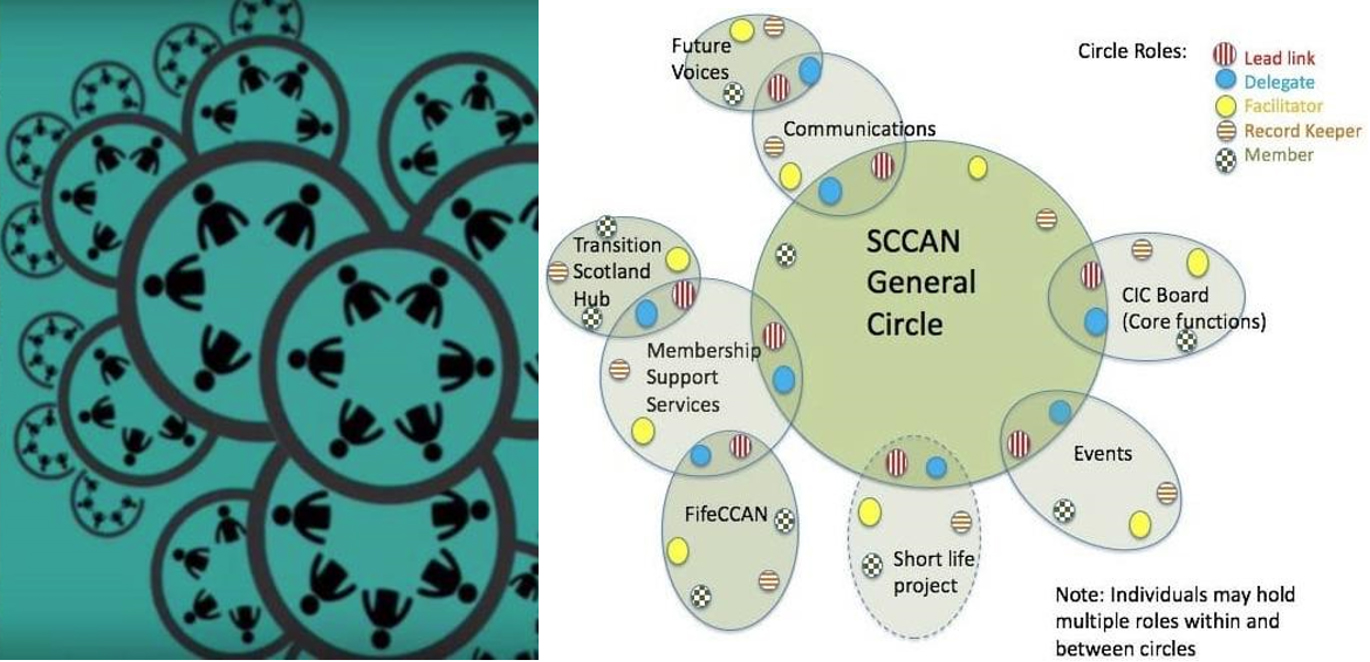
Source: Jerry Koch-Gonzalez (2016) & SCCAN (2020), arrangement Author (2020).
Image 6: Fractal governance structures
Experiments from Rojava and São Paulo demonstrate citizen-led governance structures working in nested, scaled, multiple levels. Their structures could be replicated globally for GEN, regenerative planning systems and ecocities. Ecobairro (Econeighbourhood) São Paulo aims to create ecological and peaceful communities in Brazil. Rojava stems from a feminist, ecological revolution within Syria’s civil war. Arising from a GEN training event in 2004 and incorporating regenerative concepts from Permaculture, transition towns and SDGs, Ecobairro Brasil was developed by Lara Freitas in the Vila Mariana municipality (Population: 344.632, size: 26,5 km²), one of 32 municipalities in São Paulo’s megalopolis. It incorporates a fractal structure, from micro to macro; individual, home, block, neighbourhood, network (Ecobairro Brasil, 2013) and has eight axes in its DNA: Politics, Education, Culture, Spirituality, Health, Ecology, Economy, Communication. When selected as one of five test pilots for the MiT project, it gained international profile. This led to Vila Mariana city council introducing S3. The aim of the project is the transition to a local, circular and participatory governance in which community members are encouraged to act responsibly.
Municipalist ideas inspired a revolt for autonomy by Kurdish peoples in Syria. Since imprisonment in 1999 in Turkey, Kurdish independence leader Abdullah Öcalan moved strategy from Marxist-Leninism to democratic confederalism (Finley, 2017), after reading Bookchin’s (1991) libertarian municipalist ideas. Due to the political instability in Syria, including the war against ISIS, a giant experiment is underway since 2012 in the mostly Kurdish Northern Syrian region, Rojava. A feminist and anti-capitalist society has been created (Staal, 2015), based around networks of grassroots people’s assemblies and co-operatives, or communes, a process called Tekmîl (Kurdish for report). They have declared their autonomy from the state, instead building what they refer to as a real democracy. Society is structured in fractal like fashion where communes form confederations with each other across regions. Typically, one Municipality comprises 5 districts, of 20 neighbourhoods, of 150 communes, of 2500 families. All assemblies have two co-delegates that represent their group at the upper level. Decision making is done through consensus and voting, in a bottom up process, and women are involved at all levels as equals. Regions elect fellow citizens to represent them at higher levels. There are eleven different committees or workgroups that facilitate day-to-day running of the Commune: People, Economy, Health, Women, Youth, Art & Culture, Self-defence, Martyrs, Education, Merchants, Communication. Local assemblies elect representatives at the village or street level, these delegates represent their assembly at the higher level of the city or region, and so on.
2.3. Barcelona’s experiment toward a more sustainable and just city
The 2008 economic crisis in Spain led to massive austerity cuts, bank repossessions of housing, rise in suicides and a spike in unemployment with youth unemployment rising as high as 56%. Out of this misery and anger a coordinated day of direct action happened in a network of cities throughout Spain on the 15th of May 2011 (15M). Spanish public squares were occupied by the Indignados movement for some months, who demanded a real democracy, based around daily assemblies in squares and a network of working groups. Echoing Deleuze & Guattari (1972), Castells referred to this form of urban action in his native Spain as “A Rhizomatic Revolution” (2012, p. 114), noting how after the initial actions of 15M, the structure multiplied rapidly; “Over 100 Spanish cities following suit, triggering a massive occupy movement that spread in a few days to almost 800 cities around the world”.
Building on these and more movements, citizen platforms won eight city councils in Spain’s 2015 municipal elections, including the two biggest cities; Madrid and Barcelona. All groups were from outside the traditional political party system and they took decisions collectively through local assemblies. This phenomenon was subsequently named Spain’s Rebel Cities. Barcelona saw the election of a woman as mayor for the first time in over 2,000 years; Ada Colau was the leader of the anti-eviction group Plataforma de Afectados por la Hipoteca (PAH) (Platform for People Affected by Mortgages). The citizen platform she is part of, Barcelona en Comú work on a Municipalist only platform, seeking power only at city level, based on a set of related characteristics (Shea Baird & Roth, 2017): 1) Distinctive political organization reflects diversity of local political landscape; 2) Open and participatory decision making processes; 3) Organizational structure is relatively horizontal (for example, neighbourhood assemblies) and guides elected representatives; 4) Capacity for institutional action depends on strong, organized movements in the streets that push elected leaders.
Their structure and work method is a continuation of the earlier movements they have grown from. They claim a feminist democratic revolution is underway, to further open up the urban commons in Barcelona, based on deep communication processes that allows for a city that listens. They have occupied the institutions of the mayor’s office, dispersing power by opening them up to the various assemblies in the city neighbourhoods. Image 7 shows the mayor’s team and residents discuss plans and projects that affect them. Local residents are co-creating their neighbourhoods of the future, based on open participative planning processes.
Speaking only weeks after her victory, Colau stated (2015):
“We think the city governments are key for democratic revolution, to begin governing, with the people, in a new way. But on the other hand, we’re very aware that the real change must be global, that one city alone cannot solve all the problems we’re facing, many of which are global because today the economy does not have borders”
To help facilitate wider global municipal change, Barcelona en Comú organized a three-day international Municipalist summit in Barcelona in 2017 called Fearless Cities. It had participants from every continent of the planet and was divided along 3 lines: 1) Work as a global Municipalist network: Share tools, knowledge and experiences with Municipalist movements from around the world; 2) Feminize politics: Develop new ways of organizing based on horizontal collaboration, collective intelligence and the politics of everyday life; 3) Stop the far right: Combat the politics of hate and fear with local policies to reduce inequality and promote the common good. Inspired by Barcelona’s feminist democratic revolution, the network grows. Follow up conferences happened in Central Europe, Eastern Europe, New York and Chile in 2018. In 2019 the movement published a book (Barcelona en Comú, 2019) and participated in Lisbon’s “Reclaim Europe!” event; "(Re)Scaling Networks in Portugal and Europe". Lisbon activists are now exploring how to participate in the May 2021 conference.
3. Insights from community-led initiatives in Lisbon
Lisbon was awarded the title of European Green Capital 2020 by the European Commission (EC) in 2018, in recognition of its urban development towards a more sustainable city for all. It is not Europe’s greenest city, but recent urban transformations have been recognised. The EC’s expert panel highlighted Lisbon is “particularly strong in the field of sustainable land use, sustainable urban mobility (transport), green growth & eco innovation, climate change adaptation and waste”. Lisbon joined the 100 Resilient Cites and C40 networks recently. Like many European cities before COVID, touristification, gentrification and short-term housing were driving up rents so quickly that many locals unable to pay rent were moving out of their communities in Lisbon’s historical neighbourhoods. Portugal has still the lowest minimum wage in western Europe. In 2019 Barcelona’s Ara.Cat newspaper deemed Lisbon “The new capital of gentrification and evictions”. A housing movement formed, stopping evictions, building networks of resistance, holding public assemblies, demanding politicians resolve problems and winning some policy changes. Left Hand Rotation’s documentary “What is going to happen here?” (2019) paints a vivid picture of the social upheaval of the city.
The 3-year European funded Horizon 2020 project UrbanA (2018-21) revolves around four European “arenas”, to connect “city makers” to better understand how to create sustainable and just cities. UrbanA’s Lisbon team are grounding the process in their city, while asking “How might an urban CoP help manifest the dream of a Sustainable and Just Lisbon?”. The first chapter of this process culminated with the first Lisbon “local arena” on November 12th 2019. The event happened in one of the city’s oldest neighbourhoods, which is also considered the most multi-cultural in the country, Mouraria. The day was divided into two parts. In the morning a walking tour led nearly twenty participants through the streets to Rua Dos Lagares, considered to be the epicentre of current evictions. At preselected points, CLI members spoke, including from the city’s housing network. The afternoon session happened in a city council cultural space, Mouraria Creative Hub, where more than 30 representatives from 24 different groups active in the city discussed issues for four hours. The main conclusions from the day, recorded by a graphic artist (Image 8), were the following: 1) Many solutions exist, but complex problems persist; 2) Tailor solutions to reality and local participation; 3) Need for articulation to better connect people and projects; 4) Continuity and cross-pollination is essential; 5) Inform about citizen intervention starting points. These five points form the starting point for open discussions between UrbanA and Lisbon CLIs.
In February 2020, UrbanA Lisbon shifted its focus to Marvila to identify how best can the needs of the local communities be met by transformative academic process. COVID seriously disrupted the programme. In 2021, UrbanA Lisbon began a new step, to develop a deeper relationship with three CLIs from its CoP network. These three geographically based communities were selected because they are most aligned to the regenerative idea for ecocity transformation, they have four factors in common: 1) All are in Lisbon municipality; 2) All are activating community organisation for territorial change; 3) All are marginalised communities that have received BIP/ZIP support; 4) All already incorporate food production and regenerative thinking into their projects. They are Bela Flor, Ajuda, Marvila, BAM for short (Images 9, 10).
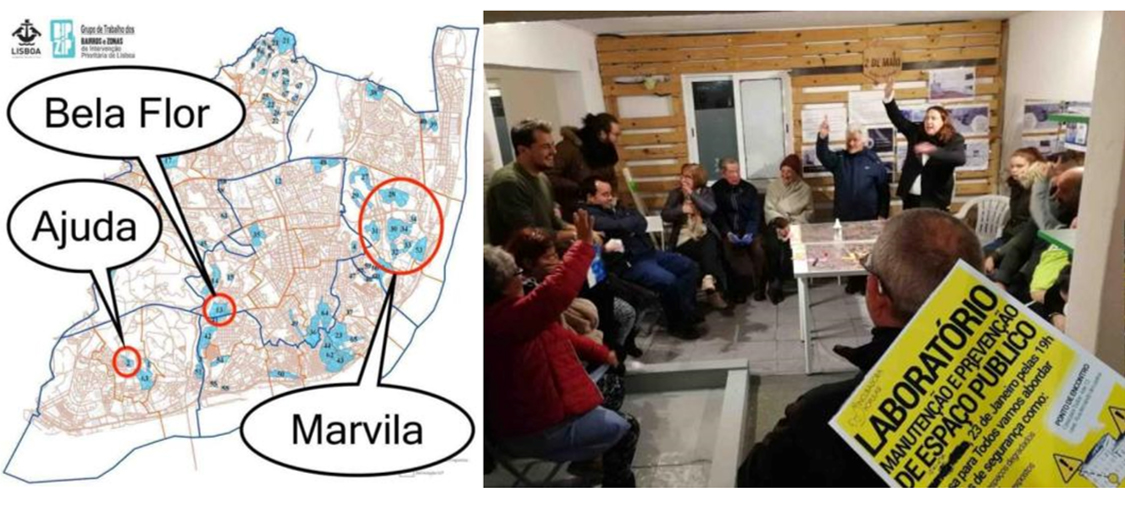
Source: Lisbon City Council, 2014 (modifications by author, 2020); author, 2020
Image 9: Lisbon Bip/Zip map with BAM identified (left) and B2M Spatial Implementation vote (right)
In 2011 Lisbon council began its BIP/ZIP process. It has been praised internationally for its innovation in improving co-governance and civic engagement in Lisbon’s most sensitive urban areas. It mapped the city and identified 67 “neighbourhoods and zones for priority intervention” in peripheral areas and the historical centre. In these island clusters (Image 9, blue areas), citizens could apply for a budget of up to 50.000 euros to work on a one-year project to improve the community. Proposals were voted on by the public and those elected received funding to develop projects for urban, ecological or social cohesion or improvement. Project creator Miguel Brito outlined BIP/ZIP’s aim:
To promote social and territorial cohesion, active citizenship, self-organisation and community participation. The aim was to ignite partnerships, to connect the city and the people in these areas to find answers for the future. (Patti, 2017)
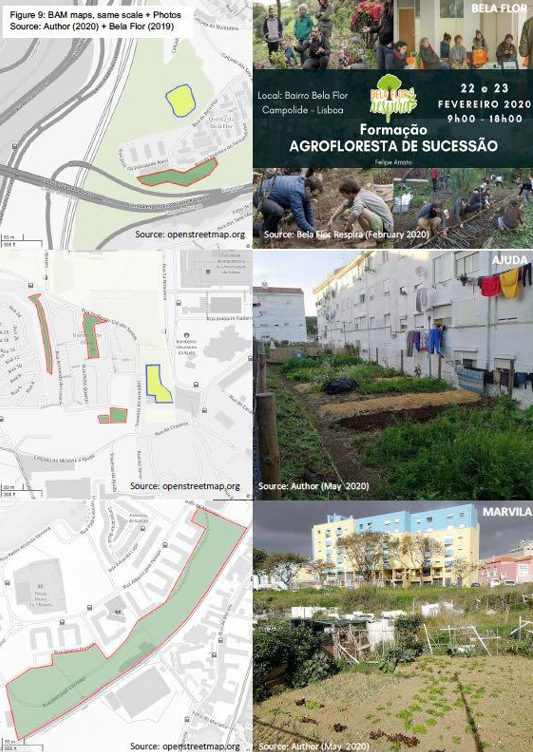
Source: OpenStreetMap, Bela Flor Respira, 2019; Author, 2020.
Image 10: BAM maps at same scale + Photos.
3.1. Bela Flor
The Bela Flor (Lovely flower) neighbourhood is on a hill that leads down to the Alcântara valley, where a major river used to flow for many centuries. In recent decades this was covered over by roads and train lines. Sadly the river is no longer visible, hidden by pipes. Until the 1990s the territory contained one of the largest informal settlements on the city edge, in the Campolide parish. In 2018 the Bela Flor Respira (BFR, The lovely flower breathes) project began in the neighbourhood (Image 10) after receiving BIP/ZIP funding. This is an ecological transition project that is transforming a forgotten wasteland into a productive and regenerative space. It started by planting fruit trees beside steps along the steep embankment leading from the housing blocks toward the city centre. Rows of mixed vegetables were planted by a flat area alongside one block. The group have a ground floor storage space for storing tools and for education purposes. It seeks to bring greater social cohesion through the creation of a community meeting space. The project was developed by the Portuguese Circular Economy NGO and is an example of a Social food movements based in the parish. The project wants to function as a teaching point in the centre of Lisbon to demonstrate and develop urban agroforestry practices. Another goal was to encourage families to separate organic waste for composting in urban gardens located in the neighbourhood. The compost products are to be used as natural fertilizers for organic plants, fruits and vegetables grown for local consumption. In this way, citizens are directly involved in closing the cycle to create a greener city.
UrbanA Lisbon helped organise an urban tour for Global Degrowth Day in June 2019, which included a guided visit of BFR with members of the team. A later UrbanA tour in October 2020 showed how old pedestrian access routes to Monsanto are now closed off. The agro ecological principles in the space are very well organised and the community space works well for the project’s needs, such as storage of tools, making recycling systems, keeping books. Although many children from the locality participated, few adults did. Most BFR participants didn’t live in the community, some living quite far away. Perhaps Bela Flor adults saw the project as a distraction for their children, but something for outsiders only? Due to BFR and other projects, the parish council has created an innovation department to support similar projects. For UrbanA’s Berlin Arena in March, a physical hub experiment will happen in the parish offices to further push the limits of the “blended arena” format UrbanA is developing. Nearby, Lisbon council are developing an urban project with bike lanes to connect the Tejo river to Campolide train station. This could cause “Green Gentrification” for the area.
3.2. Ajuda
Positioned between an old palace, the city’s green lung Monsanto park and part of the city’s university complex with fantastic views of the river Tejo, the “Bairro 2 de Maio” (B2M) community should be a much-desired neighbourhood to live in, it’s not. When the “Carnation Revolution” happened in 1974, the still unfinished housing blocks earmarked for workers of the dictatorship were occupied by poor families from Ajuda and its environs on the 2nd of May. Subsequently, it is very disconnected from its surroundings and faces difficult challenges.
In 2011 students from the neighbouring architecture school led a project to improve conditions for residents and develop relationships with the Ajuda neighbourhood. BIP/ZIP funding led to the setting up of the LOCALS approach project that is based on three pillars of intervention: 1) Transformation (Regeneration); 2) Knowledge (Information); 3) Participation (integration). BIP/ZIP funding led to the renovation of an abandoned space to create the Casa Para Todos (house for everyone), the setting up of the Feira do Galo (Roosters fair) local neighbourhood festival in 2016 and the Muita Fruta project to create an orchard city, by using all the unused fruit from city trees. In 2016 the Ajuda group set up Forum Urbano to map and archive all the municipal BIP/ZIP projects from 2011 to 2016. A later project saw residents develop self-run community gardens and in February 2020 with the “Popular incubator of Ajuda” project, fruit trees were planted in the somewhat abandoned green areas that divide blocks (Image 10). The community has its social problems, but deep democracy methods are growing, thanks to LOCALS. More residents are starting to make collective decisions about their territory. January 2020’s spatial implementation vote followed much debate (Image 9, right) concerning if police were to be allowed back into the community. This led to badly needed maintenance work happening on buildings and public space in the housing area and more fruit trees being planting. The project is being supported by Lisbon City Council.
The Associação Amigos do B2M (Friends of B2M) was officially founded in 2017, but started in May 2016 when BIP/ZIP funding stopped. It works with the most vulnerable children and youth of the neighbourhood and is run by volunteers who want to improve the future quality of social and economic life of the neighbourhood’s younger and more fragile generations. They support children and young people from 6 to 18 years in the community space, between 5 and 7 pm, from Monday to Friday. They often have up to 35 young people and children using the small space, or playing in the painted area outside.
3.3. Marvila
Marvila is a rapidly transforming riverside neighbourhood on the Eastern side of Lisbon. This port industry and working-class area was forgotten about for many decades and housed one of Lisbon’s largest shanty towns, the Chinese Neighbourhood. This was replaced in the late 1990’s by fragmented modern housing blocks of high-rise towers, amidst large, empty, unused spaces (image 11). The latest urban transformation sees rent and land prices rise rapidly, established communities being forced to leave and even evictions happening. Marvila is beaming with transformation potential. Many research and social innovation groups are already active here, working with the local government and communities to increase citizen collaboration in planning processes and to explore issues of equality and urban sustainability.
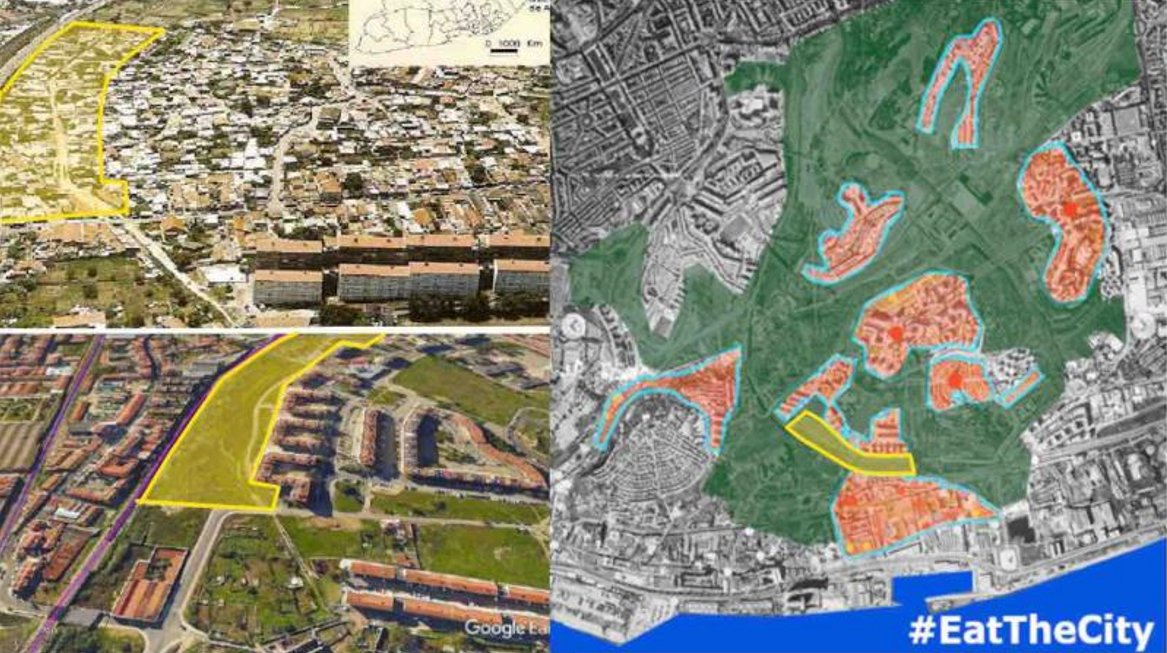
Sources: Soares, Google Earth, ROCK 2018, Author).
Note: Image 11: Transforming Marvila with parks and bikeways
In the UrbanA city series event in May 2020, Luís Matos from Rés do Chão (Ground Floor) outlined dynamics behind the CLI proposal “Transforming Marvila with parks and bikeways”. Four local neighbourhoods combined to form 4Crescente in 2010. In 2019 they rejected a proposed plan for housing blocks, arguing instead for parks and play areas they were long promised. They fought and won. The council committed to the proposal and launched an urban design project to qualify 144.000m2 (Image 11, yellow sections) of public vacant land into a city-scale public park. Luis argues this bold, ambitious project is a CLI because: 1) The initial idea came from the tenants of this public housing neighbourhood; 2) Using the resources available (and backed by the local community group) the tenants made clear their will; 3) Efforts were made to make every decision-making step as participative as possible;f 4) A community representative is part of the jury to select the final project. While this is a huge area, it forms only about 5% of Marvila’s unused area (Image 11, green area). This could be just the spot to catalyse a bold community vision for Marvila, Lisbon’s regenerative eco neighbourhood.
4. Discussion and Conclusions
Shifting from sustainable to regenerative practice combats climate breakdown, while increasing social wellbeing for all of humanity. Degrowth criticises sustainability’s relationship to perpetual quantitative growth on a finite planet. Permaculture’s post carbon pathway shows us where we must go, doughnut economics gives us the compass to get there.
Community-led initiatives hovering at the periphery become catalysts for system change when their communities of practice emerge with real power and influence to make old structures obsolete. Bridging activism and academia deepens science, gives transition tools to communities and shapes climate emergency response policy.
Fixing planetary urbanisation requires global ecocity transformations. Regenerative planning moves from what to who and how; unfolding processes of nested communities blossoming to transform their worlds, at all scales: backyard, neighbourhood, city. Scaling ecovillage approaches to ecocities demands locally owned, participatory processes remain intact. Fractal-like, multi scaled, community-led, bottom up governance experiments to enable this, already exist. Breaking through the windows of opportunity to re-make our cities is everyone’s business.
Using holistic whole systems approaches, regenerative planning frameworks identify leverage points to transform the way humans inhabit the earth. Active citizens become mutually-evolving participants in their ecosystem through collaboration. When municipalities listen and open tools, knowledge and experiences to the politics of everyday life, regenerative visions emerge from squares, assemblies and gardens. Despite the hardships, Marvila fought, Marvila won. Marvila, Ajuda, Bela Flor are transforming their worlds. Time for Lisbon to create that truly green, regenerative city, an ecocity.













